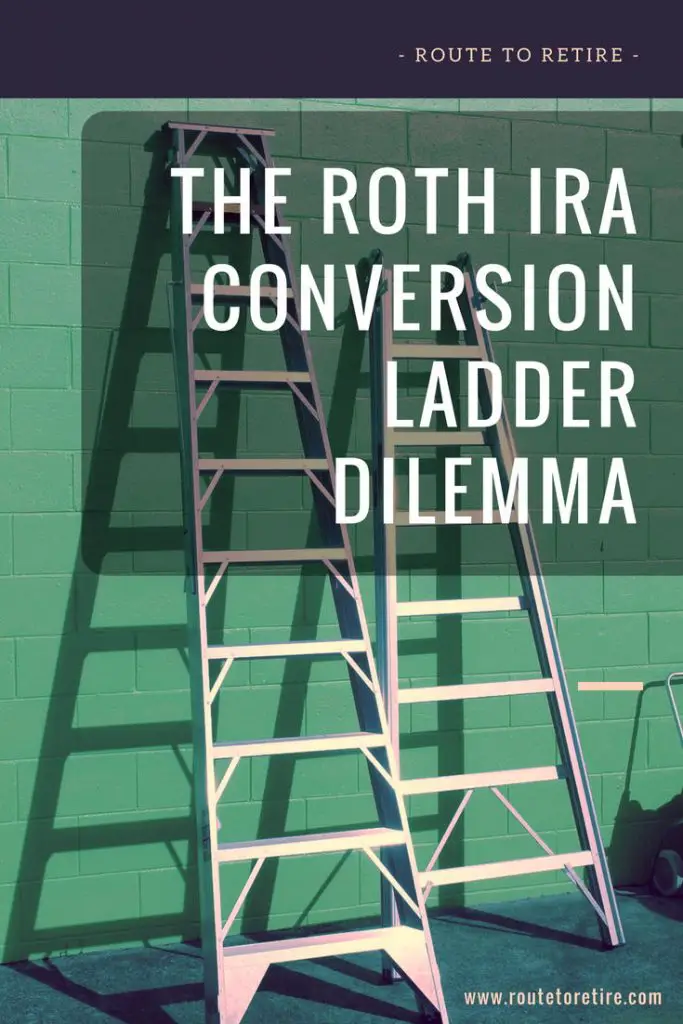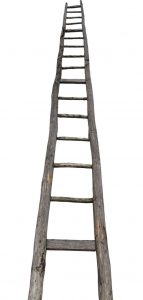
I’ve been a bit moody the past couple of weeks. I’ve been focusing a lot on trying to pinpoint our exact retirement date and I’ve been struggling. The problem all stems from the Roth IRA Conversion Ladder we plan to do.
First off, if you’re on the path to FIRE (Financial Independence/Retire Early) and you’re not familiar with how a Roth IRA Conversion Ladder works, this could be important to you.
It’s not the end-all-be-all solution, but the ladder is a method that many early retirees are able to use to make FIRE actually happen.
You see, normally you don’t have access to your traditional 401(k) and other retirement accounts until 59½. This is a problem for young whippersnappers trying to get out of the rat race once they have enough money to call it quits for good.
Yes, you can pull the money out of your retirement accounts before that age, but you’re going to be pummeled with a 10% penalty on top of the taxes. And in some cases, that 10% penalty might actually be an acceptable loss for your plan, but these circumstances aren’t very common.
So how the heck can we get to our money as an early retiree?
Enter the Roth IRA Conversion Ladder…
Roth IRA Conversion Ladder

The Roth IRA Conversion Ladder is a method of getting your money out of your traditional accounts using a little bit of a workaround. This is completely legal to do, but the method involves a little planning.
Keep in mind, there are other ways to pull your money out of your retirement accounts at an earlier age, such as the Rule of 72(t), but we’ll save that for a different post. These other methods have some pros and cons, but they don’t fit as well into most scenarios.
The Roth IRA Conversion Ladder starts with you rolling over your 401(k) into a traditional IRA once you leave your job. So far, so good – no taxes or penalties to worry about.
Once that’s done, you move your money into a Roth IRA. Here’s where things get a little trickier though.
Moving your money into your Roth IRA is considered to be a conversion by the IRS and will trigger you to be taxed on it as income. This is why you shouldn’t move it all at once. The idea behind the conversion ladder is that you move it in smaller increments to keep the taxes low.
This money is considered extra income, so if you do this while still working, it will likely leave you with a nice bill at tax time. However, if you’re now done working, these smaller amounts should keep you in a lower tax bracket.
The idea is to convert an amount you need to cover your annual expenses… say $40k. And guess what? No 10% penalty for this conversion… woo-hoo! You’ll pay taxes on it, but as I write this in 2017, it’ll keep you in a 15% bracket if you’re married. If you’re single, you might want to look at getting that number down to $37,950 to get you in the same bracket.
So you’re set, right? Now you can start pulling out that money and using it, right? Not so fast bucko!
The IRS doesn’t want to encourage people to do this, so that money is considered a conversion for the first five years. In other words, it needs to sit in your Roth IRA for five years before you can pull it out of there.
After that, it will now be recognized by the IRS as a contribution. And if you’re familiar with Roth IRA accounts, you already know you can pull out contributions from a Roth at any point in time with no penalty.
So, the ladder part of the Roth IRA Conversion Ladder comes from doing increments like this every year. Every year for the first five years, you’ll be converting money but not withdrawing anything.
In your sixth year though, you can now withdraw your first-year conversion amount. In your seventh year, you can pull on the second-year conversion amount. And so on.
Here’s a quick table to give you an idea of what this looks like. For this example, we’ll assume a withdrawal of $40k and then up that amount yearly to account for a 3% inflate rate…
| Year | Amount to Convert | Amount to Withdraw |
|---|---|---|
| 2020 | $40,000.00 | $0.00 |
| 2021 | $41,200.00 | $0.00 |
| 2022 | $42,436.00 | $0.00 |
| 2023 | $43,709.08 | $0.00 |
| 2024 | $45,020.35 | $0.00 |
| 2025 | $46,370.96 | $40,000.00 |
| 2026 | $47,762.09 | $41,200.00 |
| 2027 | $49,194.95 | $42,436.00 |
| 2028 | $50,670.80 | $43,709.08 |
| 2029 | $52,190.93 | $45,020.35 |
| 2030 | $53,756.66 | $46,370.96 |
And the table could go on and on until you’re out of money in your IRA or until you reach 59½. At that age, you can skip the Roth IRA if desired and take your normal distributions (which will still be taxed).
Freebie! I created a spreadsheet to help you see the flow of how a Roth IRA Conversion Ladder works. I initially created it to help me visualize how the conversion would work for us. However, I think it would provide some good value to you as well. I’ll send you this and a number of other valuable resources I’ve been working on just for jumping on my mailing list…
My Dilemma

So now that you know how the Roth IRA Conversion Ladder works, it’s time for me to get a little personal.
We’ve been building up our funds at a rapid pace lately. In fact, we now have enough money set aside to be considered financially independent if we take the plunge. This is assuming we move to Panama, which has a much lower cost of living. However, we have one teensy, weensy problem…
Our money isn’t allocated correctly in the right buckets for our situation. In other words, our taxable accounts are low – too low.
I’ve mentioned before that the 401(k) plan at my job offers a good match of 35 cents on the dollar invested with no max up to the federal limit. To put it another way, before I even make anything in the stock market, my dollar gets a 35% return.
I don’t have easy access to an investment that can give me that kind of return, so I max out my 401(k) plan every year.
Then there’s my HSA account – the ultimate retirement account. Tax-free contributions, tax-free growth, and tax-free distributions (when used for medical). Add in the ability to “beat the system”, along with my company’s contribution, and it’s hard not to max this one out as well!
Look, I make a decent living, but maxing out both these accounts is a fair amount of my salary. Somehow though (I feel like we save everything!), I’m maxing out my Roth IRA since that’s another tax-advantaged account.
After all is said and done, that leaves me with small potatoes to put into our savings. And what we save there, I tend to want to use as down payments on rental properties.
So here’s the problem…
We’ve built up enough to retire early. However, that 5-year waiting period for our Roth IRA Conversion Ladder to bake means we need to have enough up-front money to live on for that duration. And we don’t. Not even close.
I hate working right now, but I can’t figure out the smartest way to get out of this problem as quickly as possible.
With what we already have saved, I figure we need to come up with another $60-75k.
A Few Ideas

Sell a rental property – I hate this idea, but we’re just brainstorming, folks – there are no wrong answers! If I sold either of my rental properties, I should have enough to cover that 5-year gap.
The biggest problem though is that we’d be selling off the golden goose. And if you recall, it’s all about the geese and not the eggs! Once we would exhaust the proceeds from that sale, that would be it – gone forever! I enjoy owning the assets that keep giving us those golden eggs every month.
Take the hit – Another idea I don’t like. I could still do the rollover from my 401(k) after I leave. Then I could take the 10% penalty and start withdrawing money from the traditional IRA.
This is a horrible idea. That 10% would add up quickly and be a tremendous waste of money. And that’s the reason the IRS has it set up this way – they want to discourage people from going down this path.
Cut back on the savings – If I didn’t contribute to my 401(k) or HSA for a while, that would give me more money to sock away.
However, these are accounts that you should max out if possible because they help bring down your adjusted gross income. Not contributing would backfire as I would likely end up losing a portion of the money I saved to the taxman.
The Date

Those ideas above suck and I don’t want to go down any of those paths, so I’ve decided that I’ll just suck it up and keep on working and saving. This isn’t set in stone, but I think that I can wrap things up at the end of 2019.
This will only work if we move to Panama, which is still the plan as of now. This is definitely a tricky one though since our daughter is currently in the 2nd grade.
Right now, she’s game for giving this a shot, but the longer we wait, the harder it’ll be. She’ll start making friends at school and won’t want to leave them.
If I wrap up working at the end of the year in 2019, I can start my Roth IRA Conversion Ladder in January 2020. We’ll stay where we’re at and let our daughter finish out the 4th grade in the spring.
After that… ¡Adiós muchachos!
Relief

Not having a finite plan mapped out was really weighing on my mind. I struggled to sleep for a number of nights and was a pain at both work and home to be around (sorry all!).
I’m excited to get something more concrete going. I’m not thrilled to have to put in more work time, but I still consider us to be blessed in our situation. Our hard work should pay off soon.
If you’re new to the FIRE path and plan on using the Roth IRA Conversion Ladder, don’t put yourself in the position I did. Focus on building up your taxable accounts as well so you don’t get stuck like I did!
Have you used or considered using Roth IRA Conversion Ladder as part of your path to early retirement?
Thanks for reading!!
— Jim

Jim – I FIREd at 52 (now 57), so it’s not as hard for me as it is for you. I’ll be able to tap my traditional IRA accounts at 59.5.
You mentioned Rule of 72t that you’ll discuss later. I read a little about that and it’s a complicated rule, but it seems like it could solve some of your problem.
It’s really cool you’re planning on moving to Panama! Have you written a post on the cost of living there?
Congrats on FIREing at 52, Mr. Freaky Frugal – that’s awesome!!
You’re right about the Rule of 72(t) solving some problems such as giving an option to immediately start withdrawing. The biggest problem I have with it though is that once you start you’re completely locked in. You don’t have very much flexibility and are required to pull substantially equal periodic payments (SEPPs) every year for at least five full years or 59½ (whichever’s later). I believe you can change the set amount you withdraw one time though. I’m going to dig into it more and do a post in the near future and who knows – maybe we’ll have an escape hatch even sooner! 😉
I written a few posts on Panama (here, here, and here), but none specifically on the cost of living… thanks for the great idea!!
— Jim
Great! I look forward to reading your post(s).
Hi Jim,
What about the normal Roth contributions? You don’t need to wait ten years for the principal there.
I’d also check out 72t, if your fifty five at separation or you do equal payments it’d cover that period.
True on the access to my existing Roth contributions. However, I’ve only recently started maxing out my Roth so my account as large as it could be. I’m actually counting those contributions we have in both Roth accounts as part of the money to help cover us for those first 5 years.
I’m currently 42, so I’d have to do the substantially equal periodic payments (SEPPs) every year until 59½. That non-flexibility scares me, but I’m going to dig into it a little more thoroughly to make sure I don’t miss out on an opportunity if it makes sense.
— Jim
Hey Jim,
While I’m still several years away from FI, I’ll probably be in a similar situation as you. As it stands, the bulk of my retirement savings is in pre-tax accounts since I max all of them out for tax purposes. Hopefully my after-tax buckets will catch up once my student loans are gone. I’ll need to reassess things once my loans are off the books.
I’m thinking in your case that, if you’re not keen on selling the rental property, the best option would be to work a little longer. It sounds like it’s only for another two years. I think it beats having to do SEPPs until you are 59.5.
Looking forward to your post on rule 72(t).
Yeah, those SEPPs don’t sound like the best option. Keep an eye on the taxable accounts so they don’t throw off your FIRE plans! 🙂
— Jim
The easiest thing for you would be rule 72t. I think that’s a pretty good option if you don’t have enough in the taxable account. Should be okay.
The other option is to work part time. Can you make enough with this site to cover expenses? Panama should be pretty affordable, right?
How about refinancing taking some money out of your rentals?
Thanks, Joe – I’m digging into Rule 72(t) a little more now (I’ll post about it in a couple weeks). My site isn’t making enough to cover expenses yet, but I’m starting to see a little more return on it – that’ll be wonderful when it gets to that point.
I visited the idea of taking money out of one of the rentals a while back and the numbers didn’t work well, but that’s a good idea of something to revisit!
— Jim
I have a question regarding your strategy. Could you tell me why you would rollover your entire 401k to a traditional IRA rather than only the amount you intend to use for Roth conversion ladder? My understanding is that a 401k allows penalty free withdrawals at age 55 but a traditional IRA has the 10% until you are 59 1/2. Why wouldn’t you leave the money you intend to directly withdrawal from a tax deferred account where you can access it sooner? Thanks so much!
Good question, Jeanette! It’s true that you can take penalty-free withdrawals from your 401(k) at 55 (the “rule of 55”). However, there are some stipulations for this. One of the most important is that this rule only applies to an employer that you’re leaving at the age of 55 or older. That’s an issue for early retirees if you’re planning to leave work much younger than 55. Another provision is that it only applies to your current 401(k) with that employer and not any other 401(k) plans you might have out there. So if your money is spread across multiple accounts over the years, that can be an issue.
This isn’t to say that the strategy you mentioned can’t be useful for some folks. If someone’s planning to quit their job at say 50 years old, they can build up some cash to cover the first 5 years and then use the rule of 55 to cover their expenses at 55, for example.
There are a few different strategies (including combining multiple approaches), but it depends on your own situation (putting the “personal” in “personal finance”!). The Roth IRA Conversion Ladder is just one method to avoid the penalty for pulling out your money early. Another is Rule 72(t), which might be better for some folks.
— Jim
Another big item with the “rule of 55” is that your employer has to offer it.
It is not an automatic feature with 401(k)’s. And unfortunately mine doesn’t 🙁
Interesting – thanks for the heads up, Ed! I didn’t realize this was another facet that employers get to control with the plan. If that’s the case, I’m sure our wouldn’t allow it either since my employer has our plan locked down in every way possible! 😉
— Jim